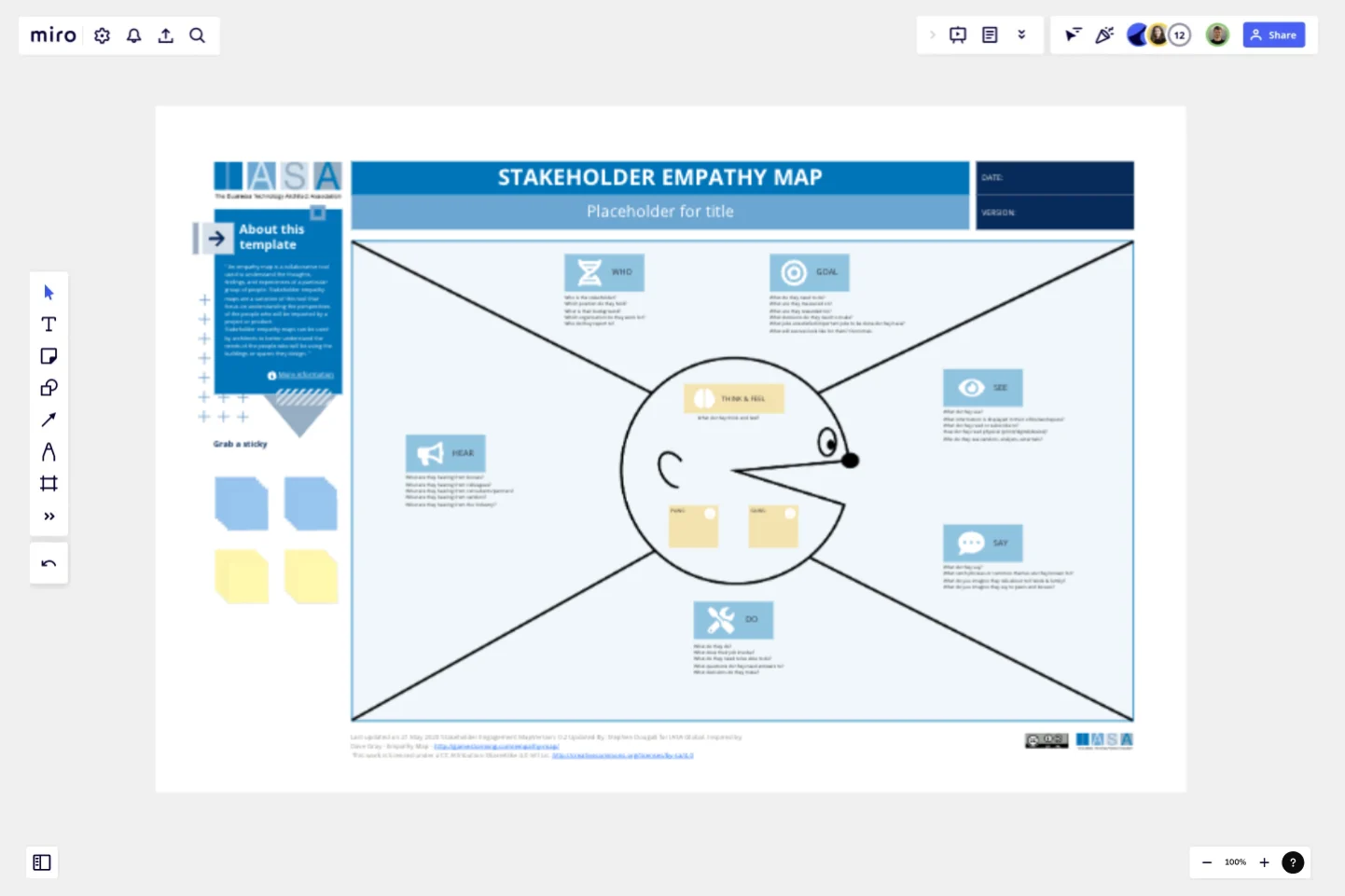Stakeholder Empathy Map by IASA
An empathy map is a collaborative tool used to understand the thoughts, feelings, and experiences of a particular group of people.
Stakeholder empathy maps are a variation of this tool that focus on understanding the perspectives of the people who will be impacted by a project or product.
Stakeholder empathy maps can be used by architects to better understand the needs of the people who will be using the buildings or spaces they design. This can help them to create designs that are more functional, user-friendly, and meet the needs of all stakeholders.
How to use this canvas
Identify your stakeholders. The first step is to identify all of the people who will be impacted by your project. This could include clients, users, employees, regulators, and the community.
Fill out the map. The stakeholder empathy map is typically divided into four quadrants: See, Hear, Say, and Do. In each quadrant, you should brainstorm what your stakeholders see, hear, say, and do in relation to your project. For example, in the See quadrant, you might list things like the project plans, the construction site, and the finished building. In the Hear quadrant, you might list things like conversations with the architect, presentations about the project, and feedback from the community.
Analyze the data. Once you have filled out the map, take some time to analyze the data. What are the common themes? What are the key needs and concerns of your stakeholders?
Use the insights to inform your design. The insights from your stakeholder empathy map can be used to inform your design decisions. For example, if you learn that your stakeholders are concerned about the amount of traffic that the project will generate, you may need to design a plan to mitigate that impact.
This template was created by IASA.
Get started with this template right now.
Design Research Template
Works best for:
UX Design, Design Thinking, Desk Research
A design research map is a grid framework showing the relationship between two key intersections in research methodologies: mindset and approach. Design research maps encourage your team or clients to develop new business strategies using generative design thinking. Originally designed by academic Liz Sanders, the framework is meant to resolve confusion or overlap between research and design methods. Whether your team is in problem-solving or problem space definition mode, using a research design template can help you consider the collective value of many unrelated practices.
Lean UX Canvas Template
Works best for:
Desk Research, Product Management, User Experience
What are you building, why are building it, and who are you building it for? Those are the big pictures questions that guide great companies and teams toward success — and Lean UX helps you find the answers. Especially helpful during project research, design, and planning, this tool lets you quickly make product improvements and solve business problems, leading to a more customer-centric product. This template will let you create a Lean UX canvas structured around eight key elements: Business problem, Business outcome, Users and customers, User benefits, Solution ideas, Hypothesis, Assumptions, Experimentation.
Pet Sitting App Wireframe Template
Works best for:
Wireframes, UX, Design
Kick off your next app design project with the Pet Sitting App Wireframe template. This template includes multiple low-fidelity app design screens, providing everything you need to quickly and easily craft a pet sitting app.
Good, Bad, Ideas, Action, Kudos Retrospective
Works best for:
Retrospectives, Meetings, Agile Methodology
The Good, Bad, Ideas, Action, Kudos Retrospective template offers a structured approach to retrospectives by categorizing feedback into five key areas: good, bad, ideas, action items, and kudos (appreciations). It provides elements for team members to share their thoughts, suggestions, and acknowledgments. This template enables teams to reflect on past performance, generate actionable insights, and celebrate achievements. By promoting inclusivity and constructive feedback, the Good, Bad, Ideas, Action, Kudos Retrospective empowers teams to foster collaboration, drive continuous improvement, and strengthen team dynamics effectively.
Practical Customer Journey Mapping by Alex Gilev
Works best for:
Customer Journey Map
Today, customers hold companies to high standards for product quality and user experience.
Service Experience Observation Sheet
Works best for:
Research & Design
The Expanded Service Blueprint provides a detailed view of your service processes and interactions. This template is ideal for comprehensive service analysis and improvement. Use it to align teams, visualize the customer journey, and identify opportunities for optimization. It's perfect for enhancing service delivery, fostering collaboration, and ensuring a seamless and efficient service experience for your customers.
